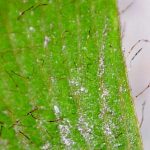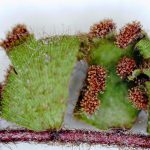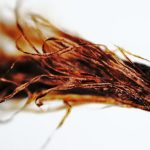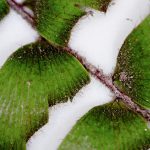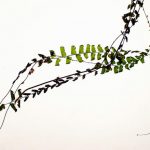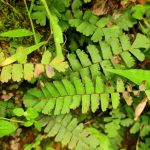|
Adiantum incisum Forssk., Fl. Aegypt.-Arab. 187 1775. (syn: Adiantum capillus-gorgonis Webb; Adiantum caudatum var. glabripinnatum Bonap.; Adiantum caudatum var. laciniata Bonap.; Adiantum caudatum var. minor Pirottain);
. Africa, Arabian Peninsula Indian Subcontinent to China (Yunnan): Angola, Assam, Bangladesh, Burundi, Cameroon, Cape Verde, China South-Central, Comoros, East Himalaya, Ethiopia, Ghana, India, Ivory Coast, Kenya, Malawi, Mozambique, Myanmar, Namibia, Nepal, Nigeria, Northern Provinces, Oman, Pakistan, Rwanda, Saudi Arabia, Socotra, Somalia, Swaziland, Tanzania, Togo, Uganda, West Himalaya, Yemen, Zambia, Zimbabwe as per POWO; .
Terrestrial herbs. Rhizome erect, 1-2 cm thick, densely scaly, scales lanceolate, about 2 x 0.25 cm, reddish-brown, acuminate, entire; stipes numerous, tufted, 6-10 x 0.1 cm, reddish-brown to dark brown, glossy, rounded below, grooved above, sparsely covered by long, soft, slender, pale brown, multicellular hairs. Lamina oblong-lanceolate, slender, up to 40 x 4 cm, not proliferate, simply pinnate; pinnae about 25 pairs, sessile or subsessile, basal few pairsslightly reduced, deflexed, subopposite, distalmost pairs progressively reduced and widely spaced, rest of the pinnae alternate, about 1-5 cm apart, largest pinna 2 x 1 cm, dimidiate, lower margin more or less perpendicular to the rachis, upper margin deeply lobed, upper base truncate and parallel to the rachis, apex-rounded; veins slightly distinct above and below, repeatedly forked, flabellate, free, reaching the margin, pinnae pale green, glabrous above and below; texture herbaceous; adaxial side of the rachis densely or sparsely covered by hairs as on stipes. Sori marginal, oblong or reniform, about 2 x 1 cm; indusia dark brown, entire, glabrous; spores 20 um in diameter, pale brown, exine faintly granulose. Evergreen forests at an altitude above 700 m
Pantropic
(Attributions- K. P. Rajesh from India Biodiversity Portal)
.
Adiantum sp. for identification: Talegaon Maharashtra: AVD11082015 : 4 posts by 2 authors. Attachments (2)
Please help me in identifying the fern: Adiantum sp.
Is it Adiantum incisum ?
Photographed on : 6th August 2015
Place: Talegaon Maharashtra if pinnae having hairs through out then it is Adiantum caudatum if only pinnules having hairs then it is A. incisum. Yes it is incisum. One day we’ll get chromosome counting going again in India, then we can know if plants like this are subsp. incisum or (as they look like superficially) subsp. indicum – as we begin to recognise the range of morphologies and the geographical/altitude range of the two subspecies.
PM 30-07-2018. Id confirmation Adiantum sp… Adiantum incisum :
presenting few images of Adiantum sp. Pic 3. Adiantum incisum? Photographed at Chandigarh, commonly found along moist walls and crevices. there is a lot of confusion regarding id of this plant. How it is differ from A. edgeworthii? Please help.
Adiantum incisum, yes – another common one. Note the characteristic hairs all over the stipe, rachis, pinnae etc. – A. edgeworthii is glabrous with a glossy stipe and rachis and smaller, with differently-shaped pinnae. A. incisum is not normally confused, but is a well known species, though in the past until about the 1950s or 60s it was often confused with A. caudatum from S. and NE India, which has much narrower lobes to the pinnae.
Adiantum incisum SN19420a : 2 posts by 2 authors. Attachments (1) – 4 mb. .
About ten days back I was in Kangra and saw this covering the brick wall of an abandoned structure. I took an couple of photos then and since I had some work to do, did not take a sample with me. I went there again today and collected a couple of fronds, including one with mature sori. Unfortunately, by the time I came back home after three hours the pinnae had curled up providing me with inadequate photos. But the sample was enough to narrow down my search to Adiantum incisum (I had posted the other two Maidenhair ferns before to this group: Adiantum tibeticum and Adiantum capillus-veneris). It was difficult to differentiate it from A. caudatum but Dr Khullar says that A. caudatum is not found in the Western Himalayas so I am assuming it is most likely A. incisum. Adiantum incisum– Please confirm.
Kangra city, HP
800m approx.
24 Feb. and 8 March 2015
Scales at the base of the stipe.
It’s not very clear in this picture but we can just make out the segmented form of the surface hair.
Yes, I’m sure that is Adiantum incisum subsp. incisum. Actually it is easy to recognise A. caudatum as that has very narrow lobes to the pinnae, but the two weren’t separated in most older literature until at least the 1980s. Requesting a fern ID.: 1 high res. image.
30/Sept/2021 Location: IISER, Trivandrum campus.
Habitat: adjoining a hillock
Habit: Herb Adiantum incisum It’s Adiantum incisum – also grows on walls in Kathmandu. A “walking fern” because the little bulbils at the tips of some of the leaves grow new plants when the leaf-tip touches the ground. I’ve seen four “generations” of vegetatively extended plants on one original leaf, even, hanging down a wall!
I have the African equivalent growing in my little fern-garden here in Portugal, but they are different taxa and I wish I had this one, but it didn’t survive the plane-journey in bags! This one is subsp. indicum, a diploid.
. References: |
Disclaimer
1. For any mistake in identification or for becoming efloraofindia e-group member (for contributing towards building of efloraofindia or otherwise), pl. mail to indiantreepix@googlegroups.com or itpmods@googlegroups.com
2. For better viewing of species’ pages, colour scheme & formatting is being followed as: Description of the species, Details of other flora species on the same page, Uses/ harms, Distribution, Abundance/ Location/ Flowering time & date, Habit & habitat, Etymology & pronunciation, Other interesting information, stories etc., Others, Botanical names, Common names, Main point of discussion below, Discussion about Botanical names.
Navigation
- Award for eFloraofIndia
- Colour scheme & formatting
- Copyrights, Permissions, Citations
- eFloraofIndia appreciated
- Names of Plants in India site
- Flowersofindia site
- Posting Guidelines
- For members’ information
- Logo, Tagline, Acronym
- Volunteers required
- ‘Pitamah’ of eFloraofIndia
- ‘अजेय’ ‘Ajey’ of eFloraofIndia
- ‘Saarthi’ ‘सारथि’ of eFloraofIndia
- ‘Jewel’ of eFloraofIndia
- ‘Grassman’ of eFloraofIndia





